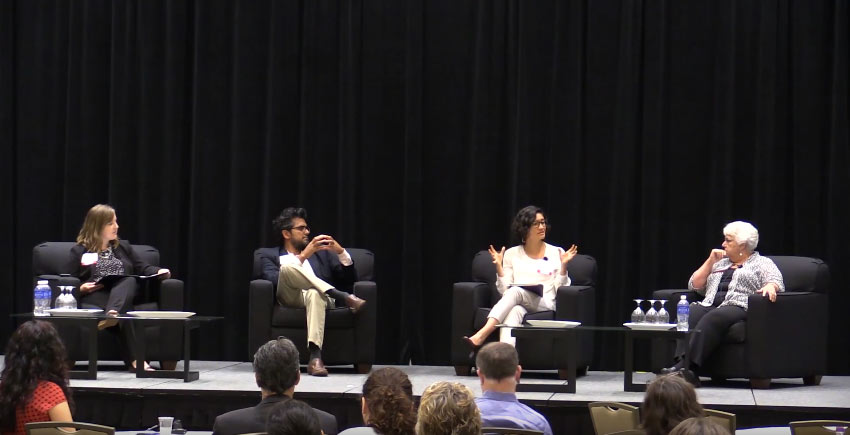Energy Efficiency and Equity and Environmental Justice: Lessons and Best Practices from Key EJ Leaders
CURRENTS Summer 2016
EJ Leaders | Building Technologies | 101 Resources | Energy Code Resource Favorites | Residential Savings Innovations
Green Leases | COP21 Video: Oakland and Richmond | CAEECC | Lessons from Germany
by Jordan Decker, Local Government Commission
Targeting energy savings in low-income and environmental justice communities is a boon for cities and counties in California; climate and energy investments in overburdened communities can improve air quality, support local economic development, and put dollars back in the pockets of those that need to avoid wasted disposable income the most. In this way, investing in energy improvements in environmental justice communities is one of the best examples of the “triple bottom line” – supporting the human, the economic and the environmental needs of a community.
Articles covering the opportunities – and the challenges – of successful energy efficiency investments in EJ and low-income areas have been plentiful this year. Coverage in GreenBiz and Eco-Business reviews best practices in keeping the cost of the initial investment off of low-income communities. The Environmental Defense Fund (EDF) recently shared (and International City/County Management Association (ICMA) reposted) statistics showing a $45 billion/year national energy “affordability gap” between the cost of energy and what households can afford – as well as best practices to ensure environmental justice efforts effectively reach and represent environmental justice communities.
At the SEEC Forum earlier this month, leaders from California’s environmental justice offices and communities came together to share their findings on what works – and what does not work – when seeking to invest in environmental justice and low-income communities. Some key findings shared include:
- Environmental justice communities may care about energy and climate, but benefit most from a holistic approach that also finds solutions to challenges they face in housing, education, lack of infrastructure, and/or job access. Communities face all of these issues and do not typically have the time or resources for a siloed approach agency-by-agency. In San Diego County’s National City, planners and organizers are reaching environmental justice communities on climate and energy issues by also addressing land use, health, housing, education, and more.
- Make it as easy as possible for community members to engage in the planning process – and engage the community early (not starting when a plan is near completion).
- Bring resources to the table to show the community the benefits of engagement and to build trust. In particular, energy efficiency assistance – including weatherization and other home assistance to help lower energy bills – can be a great tool for this. Through energy efficiency resources, you can directly improve the disposable income, comfort level, and health in community homes.
- If your department is new to outreach to environmental justice communities, you may be able to leverage the work of other departments. When Los Angeles County environmental planners were ramping up their environmental justice outreach, they learned best practices (and found helpful data) in discussions with the public health department.
- It can be overwhelming to try to engage all environmental justice communities in your jurisdiction; if you have many, focusing in on a few neighborhoods may be helpful. This tactic was used to launch Los Angeles City’s new Clean Up, Green Up Program.

Passing an environmental justice element in a jurisdiction’s General Plan – as both Jurupa Valley and National City have done – is a strong way to ensure environmental justice matters are integrated into policies and programs. With competing priorities and limited funding, it can be easy for local governments to hold off on EJ engagement and investments. However, the costs of inaction on environmental justice – such as poor health and limited economic opportunity – are costs that we are paying in our schools, communities, and governments already. An environmental justice element is a great way to see these costs addressed.
Many of these best practices are critical for equitable engagement, but also mesh well with best practices that we hear from local governments in their own climate action planning: including meeting the community on values and issues that are top priorities for them, engaging key stakeholders early in the process, being sure to translate technical issues, and working holistically to show how energy and climate solutions affect housing, education, and more.
Watch the SEEC Forum plenary session to hear more from the California Environmental Protection Agency (CalEPA)’s Arsenio Mataka, the Environmental Health Coalition’s Carolina Martinez, and the Center for Community Action and Environmental Justice’s Penny Newman.
For more background on CalEnviroScreen and SB 535, click here. Or, check out additional resources for environmental justice and underserved communities.
Local Government Commission Newsletters
Livable Places Update
CURRENTS Newsletter
CivicSpark™ Newsletter
LGC Newsletters
Keep up to date with LGC’s newsletters!
Livable Places Update – April
April’s article: Microtransit: Right-Sizing Transportation to Improve Community Mobility
Currents: Spring 2019
Currents provides readers with current information on energy issues affecting local governments in California.
CivicSpark Newsletter – March
This monthly CivicSpark newsletter features updates on CivicSpark projects and highlights.



